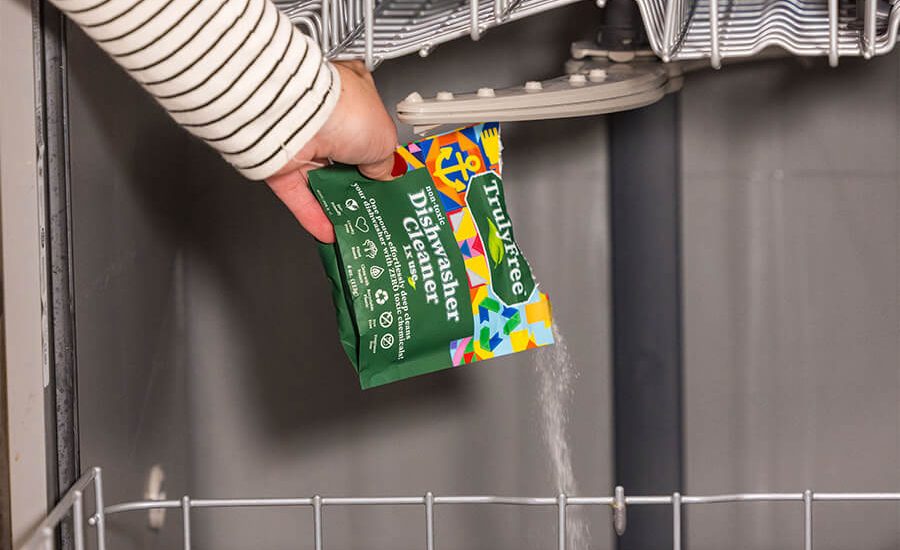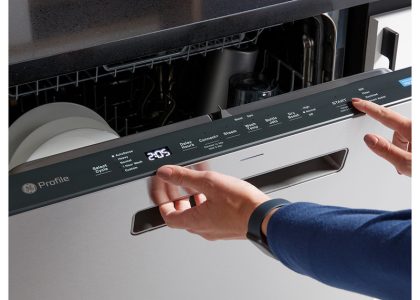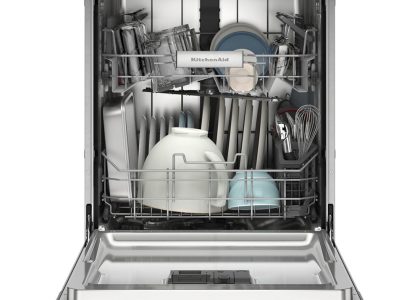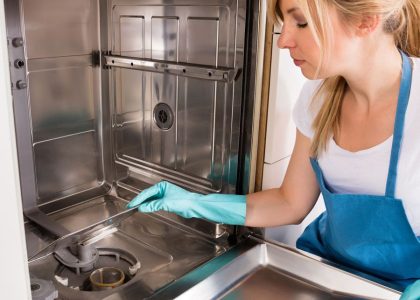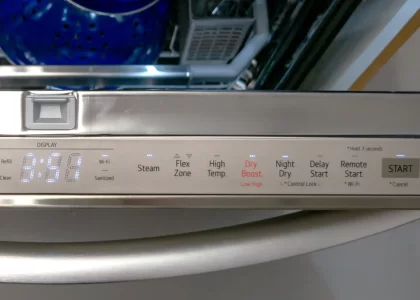Why Clean Your Dishwasher with Bleach
How to clean dishwasher with bleach? Cleaning your dishwasher is crucial for both hygiene and performance. Over time, your dishwasher may gather food debris, grease, and soap scum, potentially leading to unpleasant smells and a decrease in efficiency. Using bleach as your cleaning agent can be an effective strategy to tackle these problems. Here’s why:
- Strong Disinfectant: Bleach is a powerful sanitizer, known for its ability to kill germs and bacteria lurking in the nooks and crannies of your dishwasher.
- Odor Removal: The chlorine in bleach works well to neutralize and eliminate nasty odors, leaving your dishwasher smelling fresh.
- Mold and Mildew Combatant: Bleach is particularly effective against mold and mildew, common culprits of dishwasher contamination.
Remember, not all dishwashers are suitable for bleach cleaning, and it is important to follow specific safety guidelines to avoid damage to your appliance and ensure personal safety. Later in this guide, we’ll walk you through how to clean your dishwasher with bleach safely and effectively.
When to Avoid Using Bleach in Your Dishwasher
While bleach is a strong cleaning agent, it’s not always the right choice for every dishwasher. There are specific situations when you should avoid using bleach altogether to prevent possible damage.
- Stainless Steel Interiors: If your dishwasher has a stainless steel interior, you shouldn’t use bleach. The chemical can corrode and tarnish stainless steel surfaces.
- Plastic Components: Some dishwashers with plastic parts may not react well to bleach. Check with your manufacturer’s guidelines to confirm compatibility.
- Dishwashers with Pre-existing Damage: If there are cracks or damaged areas in your dishwasher, applying bleach could worsen these problems.
- Septic Systems: If your home utilizes a septic system, using bleach may disrupt its bacterial balance, potentially leading to system issues.
It’s essential to always read the manual of your dishwasher before attempting to clean with bleach. Knowing when to avoid bleach helps maintain the dishwasher’s integrity and protects your investment. Later, we’ll discuss how to prepare your dishwasher for cleaning with bleach, if it’s a suitable option.
Preparing Your Dishwasher for Bleach Cleaning
Before you start using bleach to clean your dishwasher, preparation is key to ensure safety and effectiveness. Here is a step-by-step guide to prepare your machine:
- Empty the Dishwasher: Make sure to remove all dishes and cutlery from the dishwasher. You want to have full access to all surfaces without obstacles.
- Check for Compatibility: Refer to your dishwasher manual or manufacturer’s guidelines to confirm that using bleach won’t harm your machine, especially if it has a stainless steel interior or plastic components.
- Inspect for Damage: Look for any cracks or damages inside your dishwasher. If you find any, it’s best to repair them before applying bleach to prevent further issues.
- Wear Protective Gear: Don safety gloves and eyewear. Bleach can be harmful to your skin and eyes upon contact.
- Ensure Ventilation: Open windows or use an exhaust fan. Proper ventilation helps reduce the inhalation of bleach fumes.
- Prepare the Bleach Solution: If your machine is compatible, mix a solution of bleach and water. Usually, a ? cup of bleach added to a gallon of water is sufficient.
After these preparatory steps, your dishwasher is now ready for a thorough bleach cleaning. In the following section, we will guide you through the process step by step.
Step-by-Step Guide to Cleaning with Bleach
Once you’ve confirmed that your dishwasher is suitable for bleach cleaning and have taken the necessary preparation steps, follow this easy guide to clean your dishwasher effectively with bleach.
- Mix the Bleach Solution: Start by preparing the bleach solution, following the ratio of ? cup of bleach to one gallon of water. Use cold water to minimize bleach fumes.
- Pour the Solution: Gently pour the mixed solution into the bottom of the dishwasher. Ensure it spreads evenly across the surface.
- Run a Wash Cycle: Set your dishwasher to a heavy wash or the equivalent clean cycle without any dishes inside. Select the highest temperature setting to maximize disinfection.
- Wait for Completion: After starting the cycle, wait for it to run its full course. Do not interrupt the cycle once it begins.
- Air Out the Dishwasher: Once the cycle is complete, open the dishwasher door to let the interior air dry and to allow any leftover bleach scent to dissipate.
- Final Rinse Cycle: After the bleach wash, run another cycle, this time with just water, to ensure no bleach residue remains.
- Wipe Down Surfaces: After the final rinse cycle, take a clean, damp cloth and wipe down the inside of the dishwasher, paying special attention to the door, seals, and any other areas where bleach might collect.
- Inspect and Return Items: Look over your dishwasher one last time to make sure it’s thoroughly clean, then you can put back any baskets or racks that you removed during the prep phase.
By following these steps to clean your dishwasher with bleach, you should have a fresh-smelling, clean, and hygienic appliance. Remember to use protective gear and ensure good ventilation throughout the process to maintain safety. Tailoring your approach based on your specific machine’s guidelines will secure the best results and longevity for your dishwasher.
Safety Tips for Using Bleach in Your Dishwasher
Bleach is a potent cleaner but requires caution. Follow these safety tips to clean with bleach safely:
- Never Mix Bleach with Other Cleaners: Mixing bleach with ammonia or other cleaning agents can create dangerous fumes.
- Use in a Well-Ventilated Area: Open windows or turn on an exhaust fan to keep air moving.
- Wear Protective Gear: Gloves and eye protection are crucial to avoid irritation from splashes.
- Dilute Properly: Always dilute bleach with water as directed before using it in your dishwasher.
- Don’t Overuse Bleach: Excessive bleach can damage seals or gaskets inside your dishwasher.
- Check for Food Residue: Ensure there’s no leftover food in the dishwasher that might react with bleach.
- Store Bleach Safely: Keep bleach in a safe place, out of reach from children and pets.
- Read the Label: Follow all instructions on the bleach container for safe use.
- Rinse Thoroughly: After bleaching, do a full cycle with just water to remove any bleach residues.
When used correctly, bleach can make cleaning your dishwasher safe and effective. Just use common sense and follow these guidelines strictly.
Alternative Cleaning Agents for Your Dishwasher
If bleach is not suitable for your dishwasher, other cleaning agents can help. These alternatives are safe for various dishwasher types and are effective in keeping your appliance clean:
- Baking Soda: A natural cleaner; sprinkle it on the bottom of the dishwasher and run a cycle to deodorize and scrub away residues.
- Vinegar: It can dissolve grease and grime. Place a cup of white vinegar on the top rack and run a hot water cycle.
- Lemon Juice: Similar to vinegar, lemon juice can remove hard water stains and freshen up your dishwasher.
- Dishwasher Cleaning Tablets: Commercially available, these are designed specifically for dishwasher cleaning without using bleach.
- Borax: This mineral compound can be used as a mild bleach alternative. Sprinkle borax inside and run a regular cycle.
- Hydrogen Peroxide: Known for its disinfecting properties, hydrogen peroxide can be used in a similar fashion to bleach but is less corrosive.
- Essential Oils: Add a few drops of your favorite essential oils to any of the above methods for a pleasant scent.
Selecting the right cleaning agent depends on your dishwasher’s material and your personal preference. Always check your manufacturer’s instructions to ensure the cleaning method you choose is safe for your appliance. By using these alternatives, you can maintain a clean and hygienic dishwasher without resorting to bleach. Remember to wear protective gloves and ensure proper ventilation when cleaning with any substance.
Maintaining Your Dishwasher Post-Bleach Cleaning
After successfully cleaning your dishwasher with bleach, it’s important to maintain it properly to ensure it remains in top condition. Here are the post-bleach cleaning maintenance tips to follow:
- Regular Inspections: Regularly check your dishwasher for any signs of damage or wear. Immediately address any issues you find.
- Routine Cleaning: Even after a deep clean, it’s good to regularly wipe down the interior surfaces and door seals to prevent residue build-up.
- Deodorize Naturally: To keep your dishwasher smelling fresh, use a vinegar rinse once a month. Just run a short cycle with a cup of vinegar on the top rack.
- Check Filters Often: Clean the dishwasher filters regularly to prevent clogging and maintain efficiency. This helps avoid the need for heavy chemical use in the future.
- Soften Hard Water: If you have hard water, consider using a water softener. This can minimize limescale build-up and improve cleaning performance.
- Use the Right Detergent: Select a detergent suitable for your dishwasher type. The right choice can reduce the need for frequent, harsh cleanings.
- Load the Dishwasher Correctly: Proper loading helps prevent damage and ensures every item gets clean. This reduces the need for repeated cycles and extra cleaning.
By following these maintenance steps, you extend the lifespan of your dishwasher and keep it running smoothly. This will result in a cleaner, more efficient appliance that doesn’t require bleach cleaning as often. Remember to always refer to your manufacturer’s guidelines for specific care recommendations.
Frequently Asked Questions about Dishwasher Bleach Cleaning
When it comes to cleaning your dishwasher with bleach, many people have questions. Here are some of the most frequently asked questions to help clear up any confusion:
- Is it safe to use bleach in my dishwasher?Yes, it’s safe if your dishwasher is compatible and not made of stainless steel or certain plastics. Always check your manual first.
- How often should I clean my dishwasher with bleach?Use bleach sparingly, only when you need to tackle mold, mildew, or strong odors. For regular cleaning, consider alternative agents.
- Can bleach damage my dishwasher?If used incorrectly or too often, bleach can harm your dishwasher’s seals and components. Follow the dilution guidelines strictly.
- What should I do if I accidentally mix bleach with another cleaner?If this happens, immediately open windows for ventilation and exit the area. Avoid inhaling fumes and contact poison control if necessary.
- How do I get rid of the bleach smell after cleaning?Run an additional rinse cycle and air out your dishwasher by leaving the door open for a while.
- What are the best safety practices when using bleach in my dishwasher?Wear gloves and eye protection, ensure good ventilation, follow dilution instructions, and never mix with other cleaners.
- Can I use bleach if I have a septic system?Generally, it’s not recommended because bleach can disrupt the bacterial balance essential for septic systems.
By addressing these common questions, you should feel more confident about how to clean dishwasher with bleach. Remember always to prioritize safety and follow the manufacturer’s instructions for the best care of your appliance.

